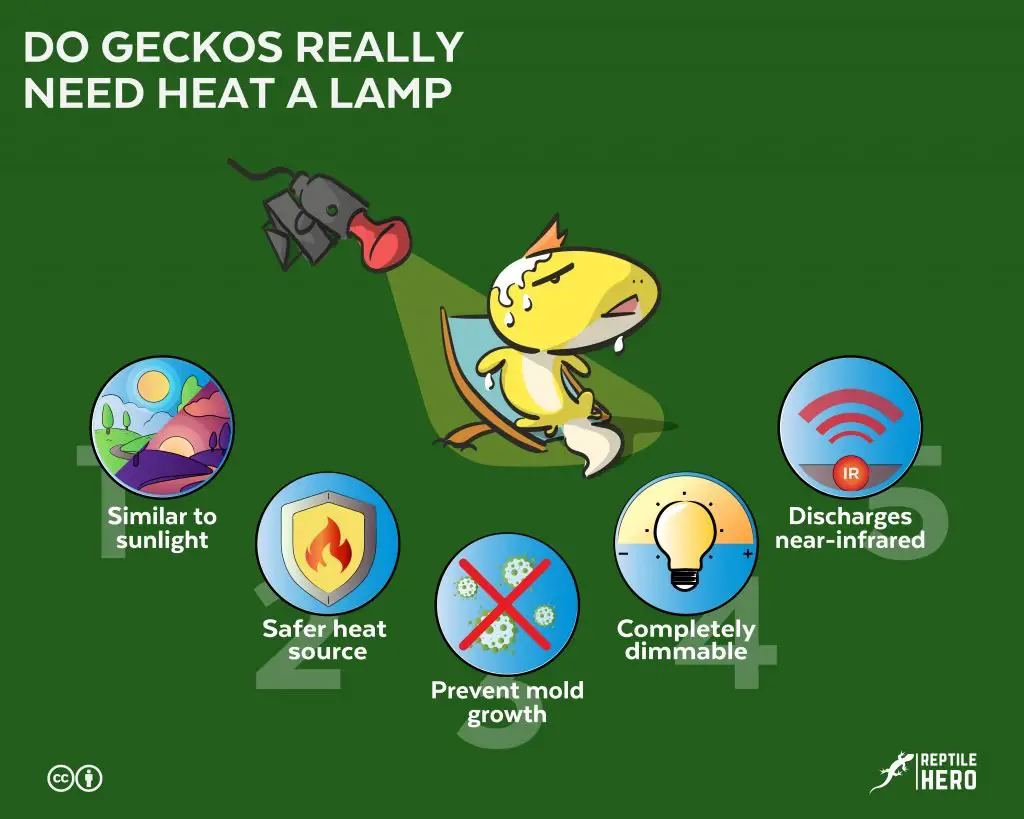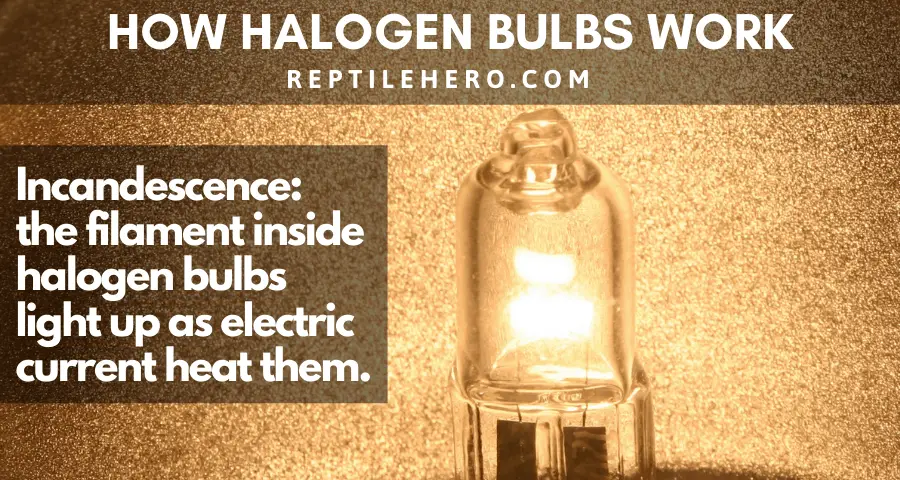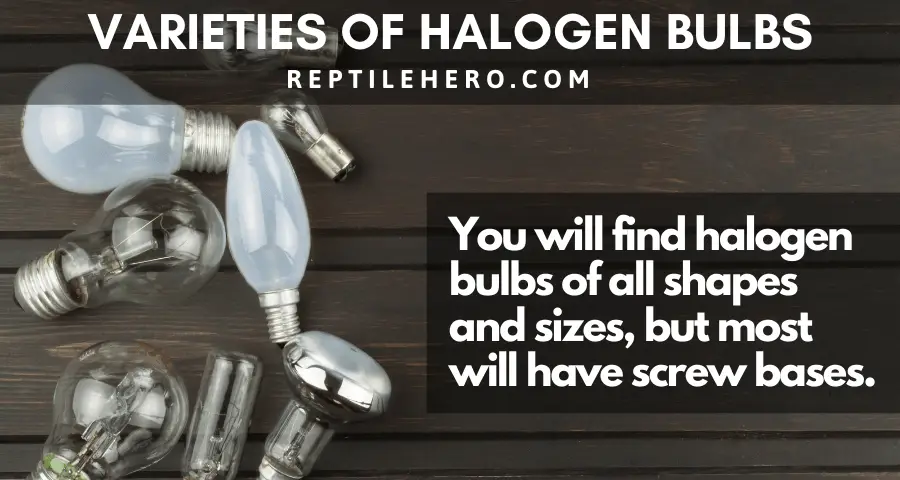Does a Leopard Gecko Really Need a Heat Lamp? [Final Guide]
Heat lamps, basking lamps, daytime lamps, sun lamps, infrared lamps, and halogen lamps: are all of these really that different? Choosing the perfect heat lamp for your leopard gecko is definitely not an easy affair but it is manageable once you get the basics down – especially with halogen heat lamps.
An average halogen bulb with a wattage of 30-100W and an internal reflector for a wide beam of bright white light can be safely used as primary daytime heat lamps for leopard geckos. More specifically, 30-50W PAR20/30 halogens are good for 20-gallon tanks. Larger tanks (25+ gallons) need 50-100W PAR30/38 halogens.
Many experts in the field of evidence-based reptile keeping consider halogen heat lamps as the closest thing to sunlight you could possibly provide for your leopard gecko. But not all kinds of halogen lamps are the same – even if they all have internal reflectors. Keep on reading to find out more!
5 Reasons Why Leopard Geckos Need a Halogen Heat Lamp
If you are still hesitating on getting your precious leopard gecko a halogen by the time you have found this article, let me emphasize exactly why you should get on with buying yourself a box or two.
Here are 5 important reasons why your leopard geckos should have a halogen heat lamp:
- Highly similar to sunlight. As halogen heat lamps produce heat and light similar to sunlight during dawn and dusk, they facilitate a naturalistic day-night cycle.
- Discharges near-infrared. It doesn’t produce only skin-penetrating heat (IR-C), it predominantly gives off thermal radiation in the IR-A and IR-B spectrum which helps leos feel the warmth to their very core.
- Safer heat source. Since it is installed at the top of enclosures, your leopard gecko will have no direct contact with it that could cause severe burns.
- Completely dimmable. You can usually dim a halogen, meaning you can readily regulate both its light and heat output.
- Prevent mold growth. Owing to the fact that heat does dry an environment, you will have little to no chance of experiencing mold problems within your leo’s vivarium – this is especially important if you are expecting to get eggs.

5 Practical Tips for Heat Lamp Installation
Some people think installing a halogen lamp is a breeze, others think it’s a total chore. Either way, all pet parents planning to give their cute little leopard geckos should keep a few tricks in mind during installation.
The following are 5 great tips for hassle-free halogen lamp installation:
- Keep it warm. Place your halogen, and other heating and lighting elements on the same side of the vivarium – the warm side. Doing this will help you keep a good thermal gradient, they can go basking on one side and cool down in the darker, cooler end.
- High up. Make sure that the heat lamp is set at least 12 in (30 cm) away from the surface of the basking platform. This allowance ensures the safety of your leo.
- Check for compatibility. Before you check out all the fittings and fixtures you have your eyes on, make sure they can be used with your halogen bulb (e.g., type, size, etc.)
- Always regulate. Any heat source, including halogens, must be thermoregulated properly with a dimming thermostat. Pulse and on-off/heat-mat thermostats are not appropriate for light-emitting sources because they will cause flickering of light.
- Get a timer. Invest in either a power outlet with a timer (here on Amazon) or, better yet, a smart plug like this one on Amazon which has a schedule and timer function that lets you control it without a hitch through your phone.
How do Halogen Heat Lamps Work?
Through a process called the halogen regenerative cycle, halogen heat lamps can continuously produce and distribute a sizable amount of both visible light and heat, 15-20% and 85-80% respectively [1]. It may also emit an insignificant amount of UV, less than 1%.
Like most lamps using incandescent bulbs, once you plug in a halogen lamp to a socket – be it directly from the wall, a power strip, or a portable power station – the electrical current will flow from the power source to the lamp/bulb socket and then the filament. A filament that has heated up will subsequently undergo incandescence and emit visible bright yellow-white light.
There are three essential steps in the regenerative halogen cycle:
- Vaporization of the tungsten filament. Upon being connected to a power source and turned on, the tungsten atoms deposited in the wire filament of the quarts capsule get vaporized and floats around in the free space within the capsule.
- Creation of tungsten oxyhalide. Once the atoms of the vaporized tungsten react with oxygen and halogen atoms, they form a compound called tungsten oxyhalide which will circulate around instead of condensing.
- Redeposition of tungsten into the filament. The tungsten oxyhalide compounds will circulate back to the space around the cool filament due to convection. During this, the oxyhalide compounds decompose while the tungsten atoms are redeposited into the filament. Then the cycle repeats.

You have this cycle, in particular, to thank for the longer life spans of halogen bulbs compared to ordinary incandescent bulbs – about 2 times more – and better light, heat, and energy efficiency.
Lighting Facts on the Halogen Lamp’s Box?
As a whole, most light bulbs have a “Lighting Facts” label printed onto one or two sides of the packaging. Comparable to the usual “Nutrition Facts” on food products, this label is intended to give consumers basic but important information regarding the bulb they are planning to purchase.
However, these are rarely found in heat lamps made specifically for reptiles like leopard geckos.
Lighting facts normally include five common factors [2]:
- Brightness. This refers to the bulb’s visible light output. It is measured in Lumens or lm. The higher a bulb’s lumen rating is, the brighter the light it emits will appear.
- Estimated yearly energy costs. Although this may be helpful for most regular users, this computation is actually incredibly conservative, if not completely unreliable for leopard gecko keepers. The costing only considers 3 hours of use per day and 11 cents (USD 0.11) per kilowatt-hour (kWh).
- Life. Again, this information is only relatively useful since it only considers a usage time of 3 hours per day. Nevertheless, you will probably see this on the packing in terms of years (e.g., 1.5).
- Light appearance. What we are really referring to when we say light appearance is the so-called warmness (yellowness) or coolness (blueness) of the light a bulb produces. This is shown as a correlated color temperature (CCT) spectrum from a warm 2600 K on the left to a cooler 6600 K on the right, with an arrow along the line to point out the bulb’s CCT.
- Energy used. Lastly, a bulb’s power or wattage rating is also indicated to specify how much electrical energy it will consume at full power. If a bulb is dimmable and is accordingly used with a dimmer, the actual energy used will be correspondingly lower. Keep in mind though, that some energy-efficient bulbs can produce similar heat and light output as higher-rated bulbs with lower power consumption – a 50W-equivalent bulb may actually only use 39W.
You may also find light bulbs with additional factors included in the packaging’s lighting facts such as restrictions and limitation of a specific bulb type’s use (e.g. not dimmable) and disclosure of mercury content.
Unfortunately, the Federal Trade Commission (FTC) only enforces this Energy Labeling Rule for regular light bulbs used at home (e.g., compact fluorescent bulbs, halogen floodlights). So when you go out of your way to get halogen bulbs allegedly made for especially reptiles for your leopard gecko’s heat lamp, you can’t be sure if they are actually true to their claims.
Varieties of Halogen Bulbs for Leopard Geckos
Among the varieties of halogen bulbs, Parabolic Aluminized Reflector (PAR) types are the most recommended and tested for use by leopard gecko keepers and experts. To be more specific, a minimum of PAR20 is needed for 20-tanks. For more spacious enclosures, PAR30 or PAR38 halogen bulbs are more appropriate.
If you have ever come across or been a part of evidence-based, science-oriented groups, forums, and conventions – even for only a short time – you probably have heard or read of PAR30/38 halogen heat lamps. To explain to you exactly what this means, let’s explore all the halogen bulbs options we can choose from.
Parabolic Aluminized Reflector (PAR) halogen bulbs are commonly used in the reptile-keeping community and industry for their desirable heat and light output. Compared to all other bulb types with internal reflectors, PARs are fully dimmable and are known for their ability to focus light in a certain space and direction to avoid stray light, making them suitable for indoor and outdoor use [3]. Plus, they are available with standard, short, and long necks.
Halogen PAR bulbs are not the only types. There are 7 more types of halogen lamps:
- Arbitrary (A). When we are asked to picture a light bulb in our mind’s eye, we usually imaging an A-shaped bulb, also referred to as a classic, pear, or traditional bulb. This is one of the oldest and most conventional types of bulbs available.
- Flame (F). Flame-shaped bulbs, as their name suggests, are chandelier-type bulbs that are mostly used for their decorative appearance in displays and ambient light fixtures.
- Bullet (B). Just like F bulbs, B bulbs are chandelier-type bulbs commonly only used for ornamental lighting in parties and other festivities (e.g., bulbs used for Christmas lights).
- Reflector (R). These bulbs are typically used for flood lighting, track lighting, and recessed lighting. Because R bulbs have internal reflectors – a reflective mirror-like coating – in their housing, they can focus high levels of light and heat outwards, not just in a small and tight circle.
- Bulged Reflector (BR). A BR bulb is basically just an R bulb that also has a rounded protective lens cover. Though both are for household uses, the additional reflective coating which bulges inside the neck of the BR bulb helps it produce a wider light beam compared to R bulbs of the same specifications, even when installed from the same height. They are usually used for bright but soft lighting within the house.
- Multifaceted Reflector (MR). Bulbs that are classified as MRs are built with pressed-glass reflectors that make them great lighting options for cases where bright light beams need to have crisp and definite angles. You will see them used for bicycles, art displays, and modern projectors, among other things. These may have filament capsules with IR coatings that will redirect heat and transform it into light to improve efficiency.
- Aluminum-faceted Reflector (AR). Halogen bulbs falling into the AR category are mainly used for specialty accent-lighting applications. With this said, you also won’t readily see them with the typical-screw type base which you can easily install at home.
When you see these bulbs in stores, physical and virtual, the bulb-type acronyms are followed by a set of numbers. Such figures pertain to the diameter of the bulb’s lens and are equivalent to an 8 of an inch. For example, to get the diameter of the PAR30 halogen bulb’s lens, simply divide 30 by 8 – 3.75 inches.

Aside from these, you may also see that some have an additional set of letters and numbers. These additional characters specify the base type of a bulb. But you won’t have to do any calculations for this as the number is equivalent to either the base’s diameter or the distance between two pins in millimeters (mm).
Regular halogen bulbs may have any of the following base types:
- Screw (Edison or E). Out of all bulb bases, E bases are the easiest to find and install. You only need to twist it clockwise into the corresponding bulb socket until it locks securely into place.
- Plug-in (Bi-Pin/Post or G). As the name suggests, its alternate names suggest, a G base usually has two pins protruding from the very bottom and plugged into the appropriate bulb socket. But some designs are supposed to be connected to the socket with the twisting method instead.
- Twist-and-lock (Bayonet or BA). Much like a G base, BA bases have two pins too. However, instead of being located at the bottom, the pins of a BA base are placed on either side of the base’s diameter. This base is also connected to its befitting socket by the twist-and-lock method.
- Slide-on (Wedge or W). More commonly than not, smaller-sized light bulbs are commercially and readily available with a W base. They typically also have low wattage ratings.
Seeing all these choices, you may have already realized that not all halogen bulbs are good in terms of keeping your soft-bellied little babies. PAR30 and PAR38 halogens with screw bases are the tried and tested choice for generously sized vivariums with internal capacities of 25 gallons and more. However, a PAR20 halogen will do for a 20-gallon.
Other than that, some of my friends have also tried out MR, BR, and R bulbs of comparable sizes for bigger sun-loving reptiles with great success. But such tests aren’t common for leopard geckos. So, personally, I will be sticking to PAR halogens since they are the safest bet.
Light Distribution of Halogen Bulbs: Spot vs Flood
Halogen heat lamps that produce a wide beam of light, otherwise termed floodlight, are preferable for leopard geckos. Using halogen bulbs that emit a concentrated, intense, spotlight with this species is dangerous because this produces higher thermal radiation compared to a floodlight, all other specifications accounted for.
Back in 2006 [4], a couple of reptile hobbyists conducted a cool little experiment to test out precisely how much heat different types of light bulbs – not just halogen – emit from a height of 12 inches (30 centimeters).
| Bulb No. & Brand | Power Rating | Light Distribution | Temperature After 2 Min. | Temperature After 5 Min. | Temperature After 10 Min. |
| 1 – ACE | 100W | Flood | 205°F | 226°F | 226°F |
| 2 – GE | 100W | Spot | 158°F | 257°F | 271°F |
| 3 – GE | 100W | Flood | 128°F | 178°F | 187°F |
| 4 – GE | 50W | Spot | 185°F | 193°F | 196°F |
| 5 – GE | 50W | Flood | 123°F | 138°F | 141°F |
As you can see from the table above, after 10 minutes of being turned on at full power, halogen spot lamps easily heat up the flat, black, metal disc they called the heat collector compared to their flood lamp counterparts. Temperature readings were collected with a non-contact infrared temperature gun.
Notably, the first halogen flood lamp went well above 200°F (93°C). However, the enthusiasts who did the experiment did really go into details with the specifications of all the bulbs they used and not all kinds had both the flood and spot variants. So we can’t really say for sure whether halogen lamp no. 1 produces lower thermal radiation than its spot lamp counterpart.
Moreover, it’s important to take into consideration that not a single heat lamp was regulated with a dimming thermostat or plug-in dimmer. So if properly thermoregulated, a modern halogen heat lamp can be – and has been for years now – safely used for keeping leopard geckos.
Aside from the fact that spotlights only concentrate the light and heat emitted by a halogen lamp into a pretty tight beam, pet parents have had issues keeping the rest of their leopard gecko’s tank with an optimal thermal gradient, ambient, and surface temperatures. They say the tiny spot right below the spot lamp can quickly reach 100°F (38°C) but the rest of the tank could stay well below 65 °F (18°C).
Remember: the ambient temperature on the cool side should be within 70-80°F (21-27°C). In contrast, the warm side should be in the 85-90°F (29-32°C) air temperature range with a 95-100°F (35-38°C) basking spot. Surface temperatures for either side should be in the lower range.
Are halogen heat lamps really dangerous for leopard geckos?
Halogen heat lamps are only as dangerous and deadly as other heat sources – with the only exception of electronic reptile heat rocks – which are neither properly regulated nor installed.
Power Rating and Consumption of Halogen Heat Lamps
On average, bigger leopard gecko vivariums will need halogen heat lamps with higher wattage ratings. The minimum 20-gallon tank will need 30-50W, 25-50-gallon tank will require 50-75W, and 55-gallon and bigger tanks should have 75-100W halogens.
Generally speaking, higher power ratings translate to higher heat and light output when it comes to halogen bulbs. In the reptile-keeping community, appropriate halogen heat lamps can have a power rating of up to 250W [5]. However, crepuscular species – those active during dawn and dusk – including leopard geckos fare better with lower-wattage heat lamps, 100W and less.
Now, besides enclosure size, the primary material composition will also be considered. Leopard geckos housed in wooden and plastic (i.e., polyvinyl chloride or PVC) enclosures, both of which are offered by Zen Habitats, would work great with halogens that are on the lower end for the range of appropriate power rating according to the general tank sizes. This is particularly because of their higher heat-retention or insulation capabilities.
Glass, on the complete opposite end, is extremely infamous among most reptile pet parents for its poor heat retention (especially during winter power outages). So it makes absolute sense that these need one or two halogens mid or high-wattage bulbs – again, according to the general vivarium size.
Of course, if you live in a relatively cold area where you basically can’t leave the house and go out for a quick errand, you need two or more fairly high-wattage halogen heat bulbs. Or just a single halogen operating alongside a non-light emitting secondary heat source which can keep your adorable leo warm throughout the night.
If electrical energy consumption and costs weigh heavy on your mind, you have to realize that keeping a single adult leopard gecko won’t actually greatly affect your daily, weekly, or even annual electricity bill. But if you still prefer energy-efficient halogen bulbs, you can find those quite easily nowadays, like this one on Amazon which I use along with most of my friends.
Color of Light Output from Halogen Lamps
Dark purple, blue, red, and white. Does the color of light really make a difference when it comes to keeping our lovely scaly babies happy and healthy? Read on to find out what is true and what is a myth.
The Meaning of Light Colors from Gecko Heat Lamps (and More!)
Humans perceive full-spectrum light as a predominantly bright white light which is, in reality, the combination of all the different color combinations within the visible light spectrum [6].
This fact was discovered by Isaac Newton in 1666 after letting a slim ray of sunlight pass a prism. After that, distinctly different colored lights of the visible light – which we now know as the 7 colors of the rainbow – were projected onto a wall.
Sunlight comprises approximately 8% UV radiation, 44% visible light, and 48% IR which fall in the 100-1000000 nm range of the electromagnetic (EM) spectrum [6, 7].
| Spectral EM Radiation | Wavelength (nm) | Subtype |
| Ultraviolet | 100-280 280-315 315-380 | UV-C UV-B UV-A |
| Visible | 380-430 430-500 500-520 520-565 565-580 580-625 625-740 | Violet Blue Cyan Green Yellow Orange Red |
| Infrared | 740-1400 1400-3000 3000-1000000 | IR-A IR-B IR-C |
As you could probably guess from the table, IR meets the lower end of the visible light spectrum (740 nm), so light-emitting heat lamps like halogens that have a long wavelength that peaks around that range produce bright white light with a reddish shade to it.
Conversely, UV radiation converges with the higher end of the visible light spectrum (380 nm) with short wavelengths. Because of this, the color violet is commonly assigned and associated with UV. Hence the names infrared and ultraviolet.
Therefore, the color or tint of light is determined by the point at which its wavelength peak falls onto. During sunrise and sunset, the golden hours of the day, sunlight has a warm yellow to red glow to it. However, when it’s high up in the sky during the middle of the day, sunlight has a much brighter and cooler bluish-white tint to it.
What does Color Temperature Mean?
The visible light with a higher color temperature (approximately 5000 K) is seen as cool blue-white light, while light with a lower color temperature (approximately 3000 K) is recognized as yellow-orange white light.
Other than the wavelength peak, the color temperature also plays a part in how light is perceived – think red-hot to white-hot, then finally, blue-hot. However, it can be incredibly confusing for other people because light with warmer color temperatures that peak around the lower end of the spectrum (yellow to IR) is actually colder than the light of the opposite characteristics [3, 6, 8].
Simply put, the cooler the light is, the higher its color temperature gets. Inversely, the warmer the light is, the lower its color temperature gets. The peak of any light also moves accordingly as the temperature changes: high color temperature is to the high end of the EM spectrum and low color temperature is to the low end.
Below is a short video to help you clear up the confusion and clearly visualize what I mean:
As already mentioned in the clip, color temperature, also called correlated color temperature, is expressed in kelvins (K). This is only used with visible white light and not single-colored lights. Most artificial lights have color temperatures from 2400 K to 6500 K.
The color temperature of a light source, like a halogen bulb, is directly proportional to the position of its wavelength peak within the EM spectrum. Using sunlight again as an example, during the break of dawn it has a low CCT of 1850 K that gradually rises throughout the day until it lowers down again late into the afternoon when the sun sets.
An average halogen heat lamp with a low CCT of 3000 K has a peak around the IR-A spectrum making them great light-and-heat elements for our ectothermic crepuscular leopard geckos [7, 9].
What colors can leopard geckos see?
Compared to human color vision, which is primarily based on red, green, and blue, reptiles have a color vision that is not only based on those three primary colors and their different combinations (i.e., visible light) but UV-A as well [9].
However, we have yet to conclude exactly how leopard geckos see the world around them with such an addition. What we do know is that they do have colored vision even in dim lighting, similar to completely nocturnal species with colored night vision.
Do you wanna see the dimly lit world as a gecko? Check out this great article.
Does a Halogen Lamp’s Color of Light Output Matter?
In order to provide a naturalistic heat and light source similar to that which is produced by the sun, it is never advisable to use single-colored bulbs regardless of the special properties they are advertised to have.
Like I said earlier, the sun produces a bright white visible light which results from the blending of red, orange, yellow, green, cyan, blue, and violet. These are usually just regular light bulbs encased in painted, coated, or lacquered glass. Due to such glazes, instead of emitting white light, only light with the same color as the coating passes through. All other colored lights are absorbed. Here’s how that happens:
Needless to say, those red, blue, and purple-black “night” bulbs sold and marketed by big and ambiguous alike are highly unnatural. To put things into perspective, try imagining or doing a little experiment on yourself at home. Change one light bulb in any of the rooms in your house with a single colored bulb and stay in there for even just 30 minutes or 1 whole hour. I’m pretty sure you’ll quickly feel disoriented, even more so once you leave the room and are exposed to bright white light.
Plus the fact alone that they can still be seen by a leopard gecko, who has a significantly more sensitive sense of sight compared to us, easily refutes claims that they are suitable for nighttime use. Moreover, no light and heat source should be on for 24 hours a day – nighttime heat should emit no light and should only be considered if temperatures drop below 65 °F (18°C).
On average, light-emitting heating elements like halogen heat lamps should be on for 12 hours during the summer and 14 hours during the winter [10]. A good time frame to follow in the summer is 5-6 AM to 6-7 PM. For winter, go for a 6-7 AM to 5-6 PM schedule. This is based on the normal day-night cycle in South Asia, where wild leopard geckos are native.
Takeaways
Halogen light bulbs are an improved type of incandescent. They are considered inefficient household lights as they primarily radiate a larger amount of thermal radiation (IR) than visible white light. However, this is what makes halogen lamps ideal for use as heat lamps in reptile keeping.
Heat lamps appropriate for housing leopard geckos should have halogen bulbs with an internal reflector. Parabolic Aluminized Reflector (PAR) types are the tried, tested, and recommended choice. Get PAR 20 for a 20-gallon tank and PAR30/38 for a larger enclosure. PAR halogens with a flood distribution of light are especially endorsed as they create a better thermal gradient.
In terms of power rating, PAR halogen flood bulbs of up to 100W can be used for leopard geckos. Get a 30-50W for 20-gallon tanks, 50-75W for 25 to 50-gallon tanks, and a 75-100W for 55-gallon tanks and bigger.
Leopard geckos like most reptiles have a color vision based primarily on red, green, blue, and UV-A. This means that they can still see single-colored lights as bright lights, just not the brilliant bright white of natural sunlight. So stay away from colored “night” bulbs.
A halogen heat lamp should only be in operation for 12-14 hours a day to imitate the natural day-night cycle leopard geckos have in the wilderness.
Sources
[1] http://zeiss-campus.magnet.fsu.edu/articles/lightsources/tungstenhalogen.html
[3] https://blog.1000bulbs.com/
[4] http://reptileuvinfo.com/html/watts-heat-lights-lamp-heat-output.html
[5] https://ambassadoranimalsag.files.wordpress.com/2018/09/january-2018-quarterly-newsletter-ahh.pdf
[6] https://www.livescience.com/50678-visible-light.html
[7] https://www.animalsathomenetwork.com/wp-content/uploads/2020/09/InfraRed-Heating-for-Reptiles.pdf



![Can You Have a Gecko and a Cat Together? [Yes, But…]](https://www.reptilehero.com/wp-content/uploads/2021/11/Gecko-and-cat-together-cc-768x614.jpg)
![What Do Gecko Eggs Look Like? [Size, Color, and More]](https://www.reptilehero.com/wp-content/uploads/2021/03/word-image-25-768x576.png)
![Are Christmas Trees Dangerous to Reptiles? [10 Risks & 21 Trees]](https://www.reptilehero.com/wp-content/uploads/2022/01/christmas-tree-pose-risk-reptile-cc-768x614.jpg)
![6 Reasons Why Geckos Make a Clicking Sound [With Science]](https://www.reptilehero.com/wp-content/uploads/2021/01/Gecko-Vocalization-768x576.png)
